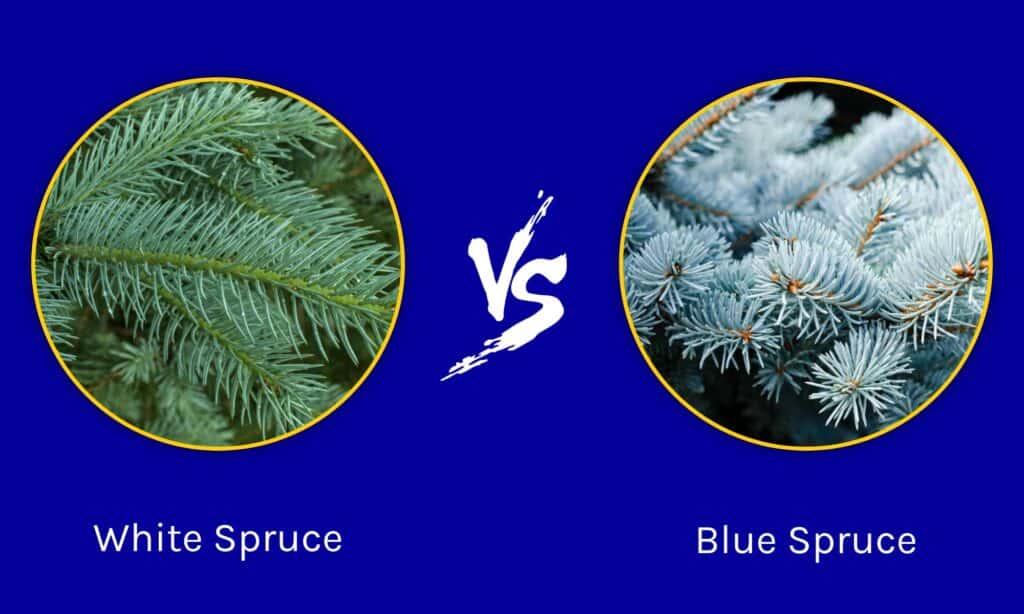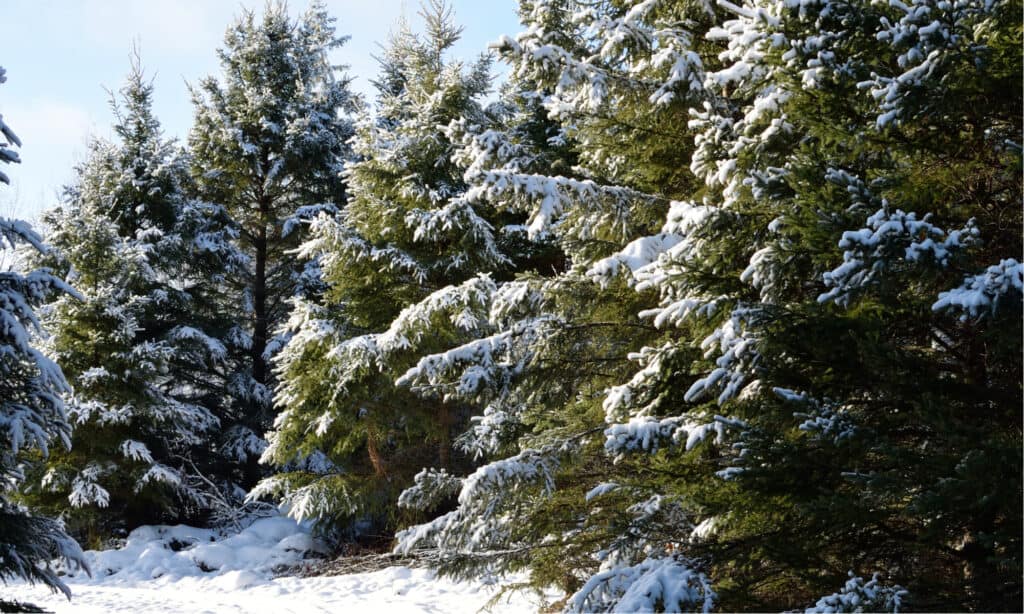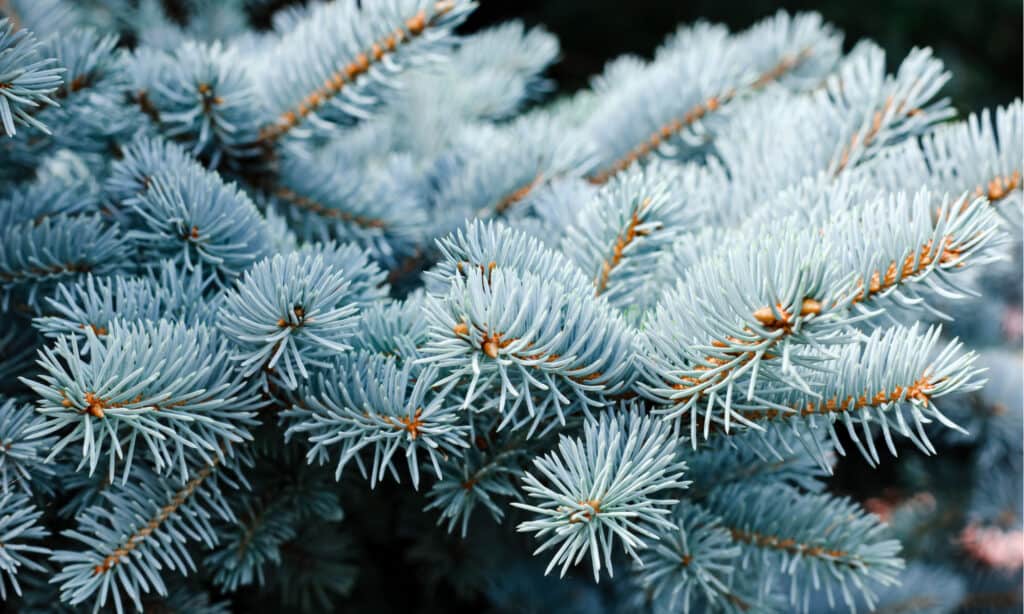Whether you are hoping to plant one in your backyard landscaping or simply want to know all of the differences between these two trees, what are some of the similarities and different rates between white spruce vs blue spruce? These two trees are from the same family and species, but they are different varieties from each other, and these differences become more apparent the more you learn.
In this article, we will go over everything you need to know about white spruce trees and blue spruce trees so that you can get a full understanding of both varieties. We will go over where they grow best, what they look like, and if they have any special features from each other. Let’s get started and learn all about spruce tree varieties now!
Comparing White Spruce vs Blue Spruce

| White Spruce | Blue Spruce | |
|---|---|---|
| Classification | Picea glauca | Picea pungens |
| Description | Light green-blue needles covered in a powder-like substance, leading to the name white spruce. Narrow treetops, with flaky bark. Needles are long and flexible. | Blue gray needles that are sharper and shorter than white spruce needles. Classic triangular shape, with scaly red or brown bark. |
| Average Height/Size | Up to 150 feet tall and 3 feet in diameter | Up to 75 feet tall and 3 feet in diameter |
| Hardiness Zones | 2-6; enjoys moist areas and well-drained soil, often found along rivers. Can tolerate shade, but thrives when receiving 5-6 hours of direct sun per day | 2-7; prefers moist environments but can adapt to survive in dry soil. Enjoys full sun throughout the day, but is overall a very adaptable tree |
| Special Features | One of the hardiest spruce trees and easy to grow; extremely popular and planted often! | Known as the Colorado Spruce; has a very deep root system to protect it in high winds! |
Key Differences Between White Spruce vs Blue Spruce

The bark of the white spruce is a gray-brown color, while the bark of the blue spruce is often a red-brown color.
©ClubhouseArts/Shutterstock.com
There are many key differences between white spruces and blue spruces. The average white spruce grows taller than the average blue spruce. The needles of the blue spruce are sharper and shorter compared to the needles of the white spruce. In addition, white spruce trees are frequently planted, while blue spruce trees are ideal for high wind areas.
Let’s go over all of these differences in more detail now.
White Spruce vs Blue Spruce: Classification
If you hadn’t guessed already, white spruce and blue spruce trees are related to one another. However, they are different varieties of spruce tree, leading to many physical differences. For example, the white spruce is classified as Picea glauca, while the blue spruce is classified as Picea pungens.

The white spruce grows longer and more flexible needles compared to the blue spruce.
©rootstock/Shutterstock.com
White Spruce vs Blue Spruce: Description
While it may take some getting used to, there are multiple ways for you to tell the difference between a blue spruce and white spruce just by looking at them. For example, the white spruce grows longer and more flexible needles compared to the blue spruce. In the same vein, the needles of the blue spruce are more gray-blue in color compared to the white-green hue of the white spruce.
The bark found on both of these trees is similar, as well as the overall shape. Both white spruce trees and blue spruce trees grow in a classic triangular fashion, with narrow treetops. However, the bark of the white spruce is a gray-brown color, while the bark of the blue spruce is often a red-brown color. Both trees have scaly or flaky bark, so do anticipate this similarity!
White Spruce vs Blue Spruce: Average Height

The average height of these two spruces often overlaps, though the white spruce can reach 150 feet tall, while the blue spruce grows up to 75 feet tall.
©Tanya49/Shutterstock.com
On average, the white spruce tree grows taller than the blue spruce tree. The average height of these two spruces often overlaps, though the white spruce can reach 150 feet tall, while the blue spruce grows up to 75 feet tall. Depending on their surroundings, most spruce trees reach up to three feet in diameter, a trait shared by both white spruce and blue spruce.
White Spruce vs Blue Spruce: Hardiness Zones
The hardiness zones and preferred growing environments of the white spruce and the blue spruce are fairly similar to one another. However, the blue spruce grows in slightly more hardiness zones compared to the white spruce. Depending on the specific tree, white spruces prefer hardiness zones 2-6, while blue spruce trees prefer zones 2-7.
When it comes to growing one of these trees in your own yard, blue spruces and white spruces have fairly similar light and water needs as well. You can often find white spruce trees growing along rivers given their preference for moist environments, though blue spruce trees are tolerant of drier climates. Both trees are fairly hardy and adaptable, though the blue spruce is more adaptable than the white spruce overall.

You can often find white spruce trees growing along rivers given their preference for moist environments, though blue spruce trees are tolerant of drier climates.
©Alexander Varbenov/Shutterstock.com
White Spruce vs Blue Spruce: Special Features
What else makes white spruce trees and blue spruce trees special? The blue spruce is also known as the Colorado Spruce, and it is the official state tree of Colorado. However, the white spruce is one of the most commonly planted spruce tree varieties available, especially compared to the blue spruce. In addition, the blue spruce is one of the most stable spruce trees for windy environments, given its unique and powerful root system, which is not shared with white spruce varieties.
The photo featured at the top of this post is © ClubhouseArts/Shutterstock.com
Thank you for reading! Have some feedback for us? Contact the AZ Animals editorial team.






